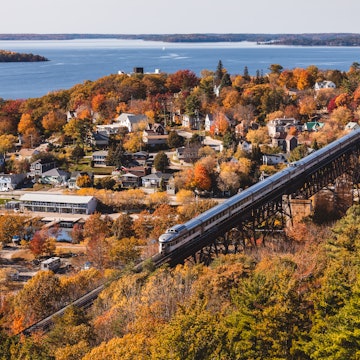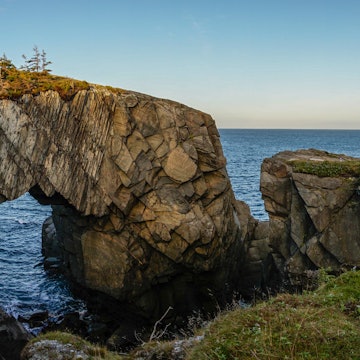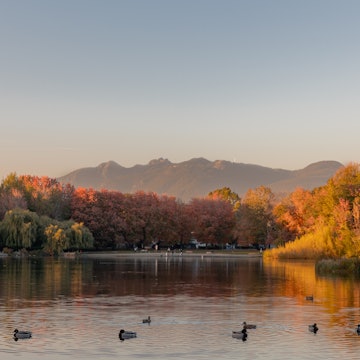
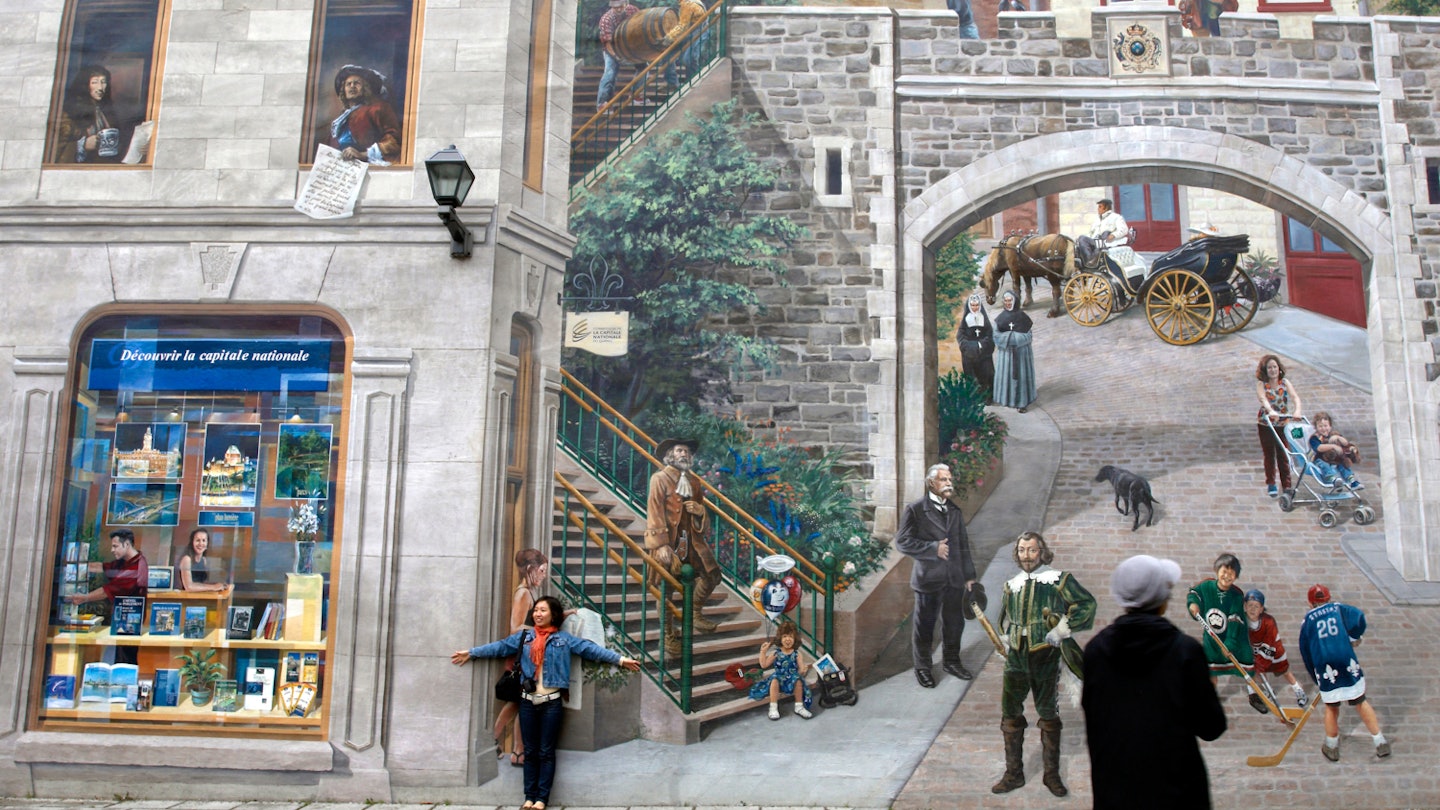
The Fresque des Québécois tells the story of Québec City’s history. Image by MANIN Richard / hemis.fr / Getty
Founded in 1608, Québec City is North America’s oldest walled city and the cradle of French civilization in the New World. It’s also a walker’s dream: compact, picturesque and brimming with European charm.
This tour reveals Québec’s rich and colorful history, taking you down narrow cobblestone streets, past mansard-roofed houses, across the legendary Plains of Abraham and alongside the mighty St Lawrence River. The route is roughly 6km, 1 hour 20 minutes of walking.
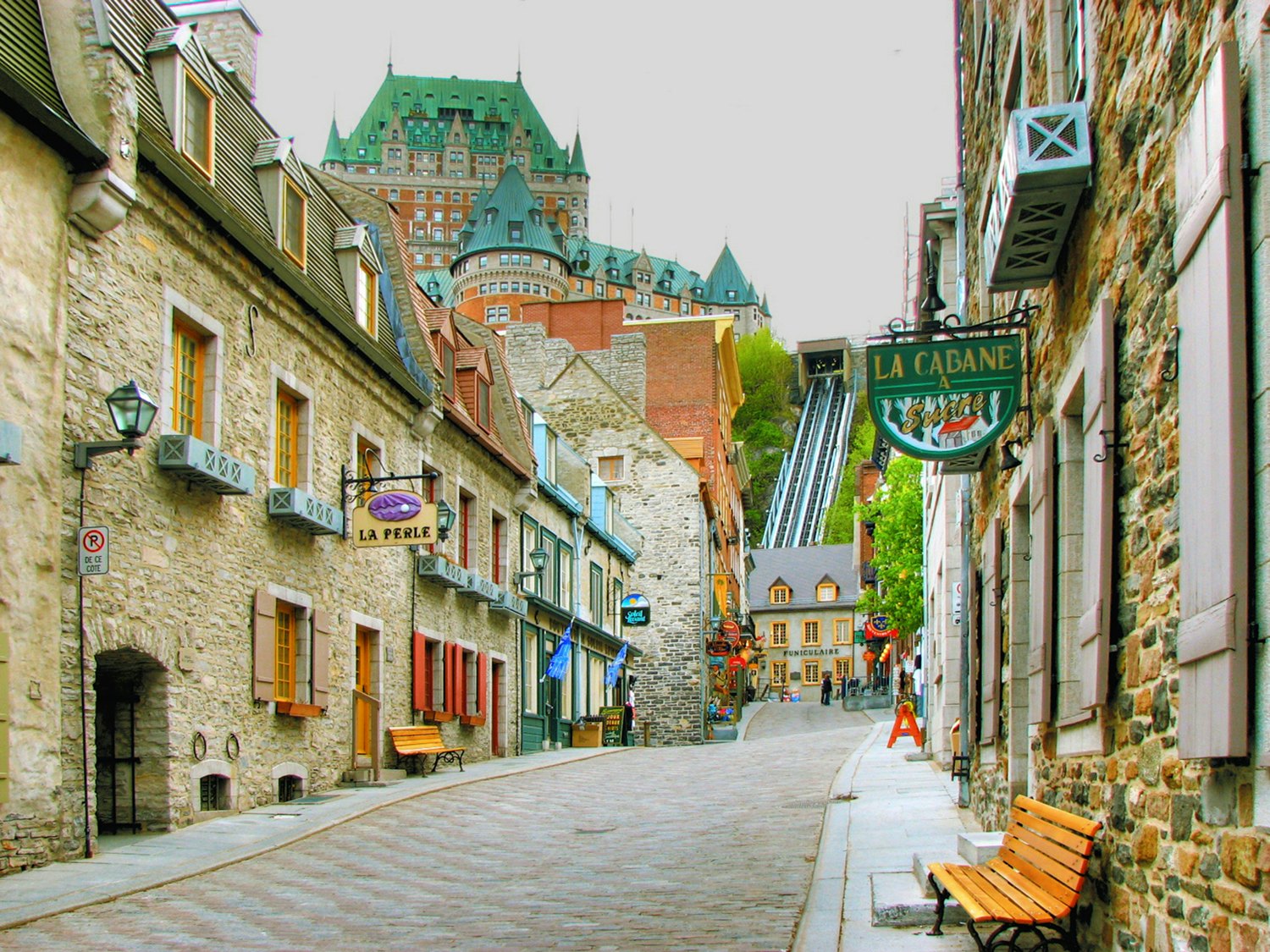
Grand perspectives on the river
For a palpable sense of Québec City’s dramatic setting, step onto the [1]Terrasse Dufferin, a magnificent 425m-long boardwalk perched atop Cap Diamant, a 60m-tall cliff with bird’s eye views of the St Lawrence River. From this vantage point, it’s easy to understand why the Algonquins (North American indigenous people) called this place kébec (where the river narrows) and why French explorer Samuel de Champlain chose this strategic site for New France’s first permanent settlement in 1608. Look for the statue of Champlain and the nearby excavations of his second fort, which stood here from 1620 to 1635.

Nowadays it’s the [2]Château Frontenac that rules these heights. With fabulous turrets and multiple wings graciously complementing its spectacular setting, this audaciously elegant structure is the world’s most photographed hotel and the uncontested jewel of Québec City's skyline. Completed in 1893, it was one of the Canadian Pacific Railway's series of luxury hotels built across Canada. Over the years, it's hosted luminaries such as Winston Churchill and Franklin Roosevelt, who gathered here for the Québec Conferences during WWII, as well as Alfred Hitchcock, who featured the Frontenac in the opening scene of his 1953 mystery I Confess. Other illustrious guests have included King George VI, Princess Grace of Monaco and Paul McCartney.
Plains of Abraham: where Québec’s history turned
Follow the boardwalk southwest and climb via the Promenade des Gouverneurs up onto the grassy expanses of the [3]Plains of Abraham, site of the pivotal September 13, 1759, battle in which British general Wolfe led his men in a sneak attack up the cliffs, catching the French unprepared and precipitating Britain’s takeover of New France. The Plains are now a historic park and a recreation paradise, threaded with cycling, skiing and walking trails and used as the prime venue for Québec City’s annual winter carnival.

As you cross the Plains, look on your right for the [4]Citadelle, a massive, star-shaped fort built by the British in the 19th century to defend against American invasion and a possible revolt by the local French-speaking population (that's why the cannons point not only at the river, but at Québec City itself!).
Inside the old city walls
Enter the picturesque heart of the Old Upper City via [5]Porte St-Louis, an impressive gate first erected in 1693 (though the current incarnation dates from 1878). To your left, backed by Québec’s old city walls, is the [6]Parc de l'Esplanade, once used for 18th- and 19th-century military exercises. Continue along Rue St-Louis, pausing at the corner of Rue du Corps-de-Garde to look for a cannonball embedded in a tree (supposedly since 1759). Number 47 Rue St-Louis is where France’s legendary General Montcalm spent his final 24 hours, after being shot by the British during the Battle of the Plains of Abraham.
At 34 Rue St-Louis, look for the traditional Québécois restaurant [7]Aux Anciens Canadiens, housed in a 1676 home whose steeply slanted roof was typical of 17th-century French architecture. Turning left onto Rue des Jardins, you'll pass a sculpture by Jules Lasalle honouring the nuns who came to Québec and educated both French and First Nations girls at the adjacent [8]Ursuline Convent. Bear gently right to reach the elegantly handsome [9]Cathedral of the Holy Trinity, modeled on London’s St Martin-in-the-Fields Church. Dating to 1800, it was the first Anglican cathedral ever built outside the British Isles, with pews made of oak imported from Windsor Castle's Royal Forest.
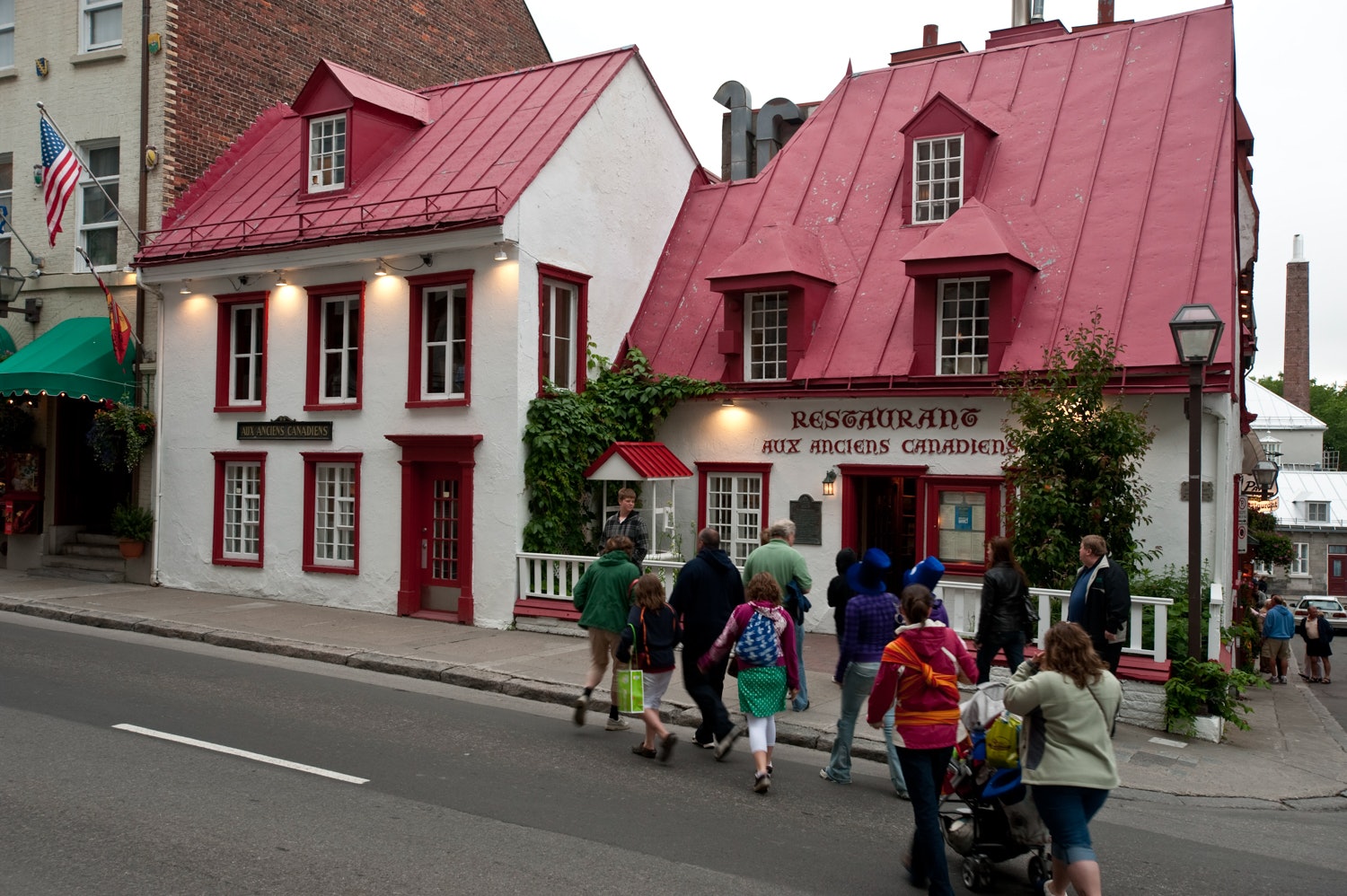
A block further on, look on your right for [10]Basilique-Cathédrale Notre-Dame-de-Québec, an imposing cathedral that got its start as a small Catholic church in 1647 but has been rebuilt repeatedly to repair damage from fires and battles, including the British-French conflict of 1759. Next door, a gate leads into the grounds of the [11]Québec Seminary, founded in 1663 as a place of religious education; it's also where American officers were locked up after their unsuccessful siege of Québec in 1775-76.
Detour briefly down Côte de la Fabrique to Rue St-Jean, where you can break for a snack at one of Quebec’s best boulangeries, [12]Paillard – its shelves brimming with fresh-baked croissants and other French-inspired delights. From here, make your way back to Rue des Remparts and follow the town walls to a fine overlook of the Lower Town waterfront.
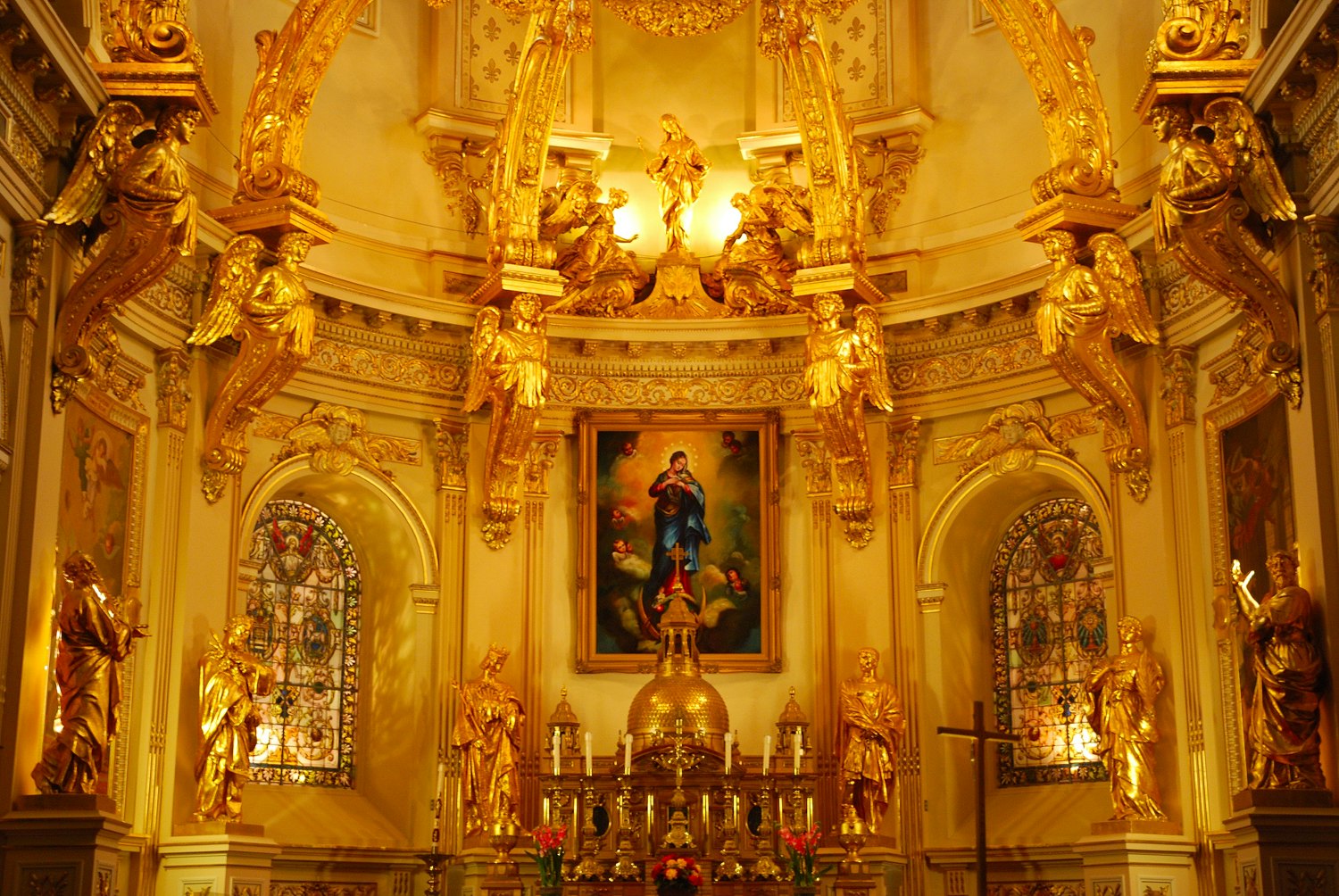
Exploring the Lower Town
Descend along Côte de la Canoterie, which for centuries was the main link between the Upper and Lower Towns (and classes); Hope Gate stood here until 1873 to keep the riffraff from entering the Upper Town uninvited. At the foot of the hill, turn right onto Rue St-Paul, the heart of Québec's antiques district, where you can browse for your very own piece of Québécois history. One block over, take a peek at Rue Sous-le-Cap, Québec City’s narrowest street and a former red-light district.

Follow Rue Sault-au-Matelot and Rue Notre-Dame along the base of the cliffs to the [13]Fresque des Québécois, a marvelous 420-sq-meter trompe-l'oeil wall painting, where you can pose for the requisite photo alongside historical figures like Jacques Cartier and Samuel de Champlain. From here it’s a short walk to [14]Place-Royale, Québec City’s original town square and home to North America’s oldest stone church, the diminutive [15]Église Notre-Dame-des-Victoires, dating from 1688 and named for French victories over the British.
Finish your grand loop with a two-minute funicular ride back up to Château Frontenac, or enjoy one last steep but scenic walk up the evocatively named [16]Escalier Casse-Cou (Breakneck Staircase). Either way, you’ll enjoy lovely views over the [17]Le Quartier Petit-Champlain, North America’s oldest commercial district, replete with boutiques housed in 17th- and 18th-century buildings.
This article was first published in November 2015, last updated December 2019.







